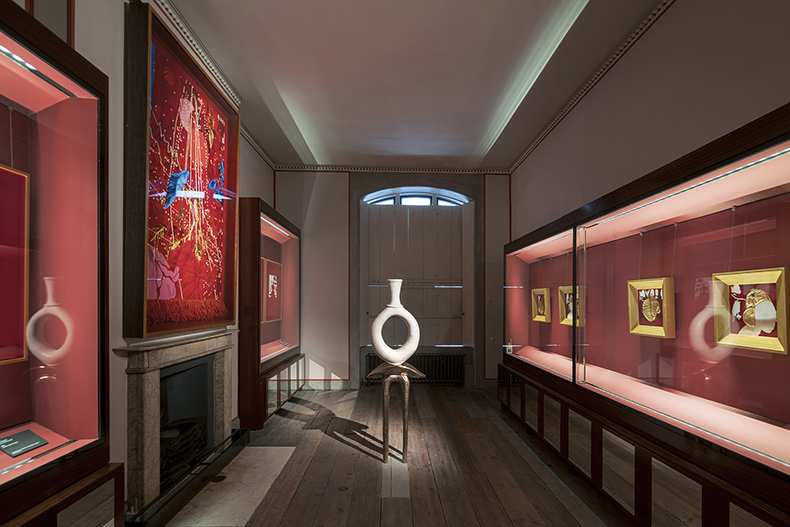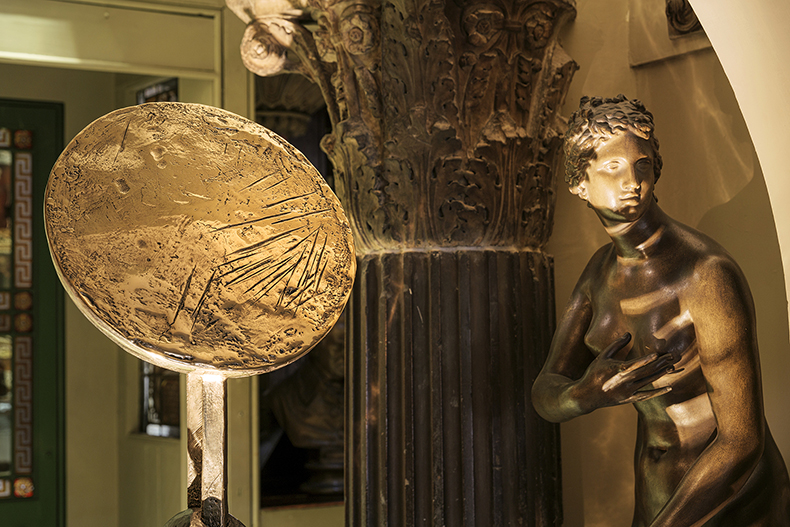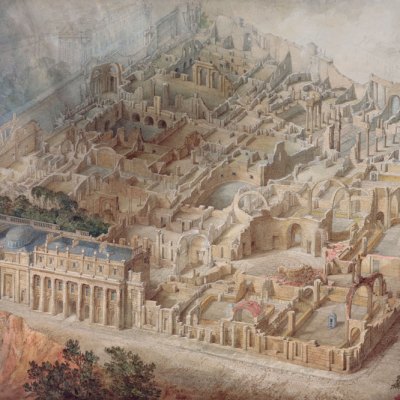When Sir John Soane negotiated with Parliament to turn his London home into a museum in 1833, the architect’s main condition was that it be preserved exactly as he had arranged it. His wishes have been honoured for nearly 200 years. The house is still packed with Roman antiquities from floor to ceiling, architectural drawings and models, and Hogarths and Canalettos squeezed, frame to frame, on the walls of a tiny picture room. It is impressive, given the scale of Soane’s collection, that the museum has created space for temporary exhibitions, the most recent of which is ‘Mythic Time/Tens of Thousands of Rememberings’, a show of paintings, works on paper, ceramics and totems by the artist Lina Iris Viktor, who has made several new pieces in direct response to the house and its contents.
Born in the UK to Liberian parents, Viktor often refers to the history and mythologies of West Africa, as well as Mesoamerican and Indigenous communities in Australia. It is these ‘rememberings’ that she weaves among the museum’s displays of classical antiquities.
Installation view of ‘Mythic Time/Tens of Thousands of Rememberings’ by Lina Iris Viktor at Sir John Soane’s Museum, 2024. Photo: Gareth Gardner

This approach is most effective in the crypt containing the alabaster sarcophagus of Seti I. Here, the bronze, ceramic and Iroko wood sculpture Nbiru (2024) sits between two casts of the Medici Venus, its triangular shape topped with a golden disc evoking both an alternative version of the female figure and the pyramidal forms of ancient Egypt. The work also refers to Sudano-Sahelian architecture: the pattern of spines jutting out from the sculpture’s sides replicate the wooden support beams used in structures across West Africa. Nearby, two 24-karat gilded oak Ritual Thrones (2024) glint in the darkness. Flanking a sculpture of Britannia, this grouping of objects reminds us of the power structures of empire and monarchy, in play within both Soane and Viktor’s contexts. The dim space was also selected for its blackness, something Viktor explores not just in reference to race but also as materia prima: the ‘original’ material from which all else emerges.
In the Foyle Space, a small room on the ground floor, are three works from Viktor’s Constellations (2018–24) series: matte-black canvases overlaid with a raised pattern of rune-like symbols covered in gold leaf. It’s not always possible to tell if they are referring to specific cultures, though the dotted circles that ripple across the canvas are reminiscent of the Dreamtime paintings made by Indigenous artists in Australia that tell their stories of creation. In the centre of the space is Web Weaver (2024), an Asante-style bronze figure as commanding as Soane’s plaster cast of the Apollo Belvedere that stands before it.
Installation view of ‘Mythic Time/Tens of Thousands of Rememberings’ by Lina Iris Viktor at Sir John Soane’s Museum, 2024. Photo: Gareth Gardner

In the upstairs galleries, Viktor turns her attention to the building itself. The curved top edges of several paintings mirror the arches that repeat throughout the museum; the use of red within the works is inspired by the deep Pompeiian red of the rest of the house. Although Viktor and Soane may share some of the same concerns – and Viktor lives a 45-minute drive from Pompeii – the exhibition shows signs of strain when it tries to draw closer parallels between artist and architect. The displays are most effective when Viktor’s work is allowed to speak for itself. Ceramic sculptures such as Soul Vessel I (2024) show the skilful application of moulding technique seen in 18th century plaster casts of Grecian and Roman works on the crowded walls, while the inclusion of banana silk and raffia creates intriguing textures in multimedia works such as Gold Coast/Silk Roads (2024).
There is plenty of gold in many of the works, and landscape paintings such as Bambouk (2024) and Bouré (2024) make reference to its lasting value; the titles refer to goldfields in the Senegal River Valley and the practice of goldsmithing among the Dogon people of Mali. Dogon architecture is also recalled in Toguna (2024), a geometric maze of gilded lines that takes rough inspiration from the ‘house of words’ that sits at the heart of Dogon villages as a meeting place for elders. This interest in ancient histories and architectural principles, and the breadth of Viktor’s references, are an elegant complement to the museum’s collection; were Soane still alive, it’s not hard to imagine him making Viktor’s work a permanent fixture.
‘Mythic Time/Tens of Thousands of Rememberings’ is at Sir John Soane’s Museum, London, until 19 January 2025.



